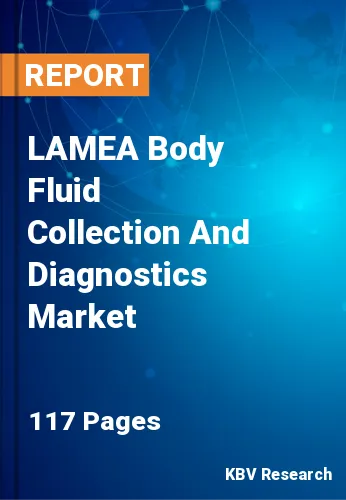The Latin America, Middle East and Africa Body Fluid Collection And Diagnostics Market would witness market growth of 10.4% CAGR during the forecast period (2022-2028).
The therapeutic screening and health evaluation are also done by testing body fluid. A number of medical decisions depends on the results gathered by the examination of the body fluid in a clinical laboratory. Therefore, the clinical laboratory has the responsibility to provide authentic data for the identification, diagnosis, prognosis, treatment, and prevention of human disease.
It is highly necessary that the clinical laboratory is adequately equipped with the latest and most reliable analytical methodology to examine chemical species in biological fluids. The physicians use body fluid cellular diagnosis to get necessary information about the patient’s health conditions, along with inflammatory diseases, hemorrhage, infection, and malignancy.
Earlier, body fluid analysis was conducted manually with an optical microscope, which is remarked as a gold standard method for counting cells. Manual evaluation requires a significant time to be spent on it, and is labor intensive. A load of body fluid diagnosis only rises with increasing pressure and less resource availability.
The UAE government has made developing a top-notch healthcare infrastructure as a primary priority; as a result, the industry has developed and grown tremendously over the past few years. The populations with relatively high levels of income will seek higher quality healthcare as the prevalence of lifestyle diseases rises. To meet this demand, the government is concentrating on building healthcare infrastructure. In order to make Dubai a regional hub of superior healthcare, the UAE government intends to increase the number of medical tourists visiting the country. Better surgical and diagnostics facilities are being offered as a result of the region’s focus on boosting medical tourism and providing the best healthcare facilities available. All these elements are predicted to support the market expansion in LAMEA region.
The Brazil market dominated the LAMEA Body Fluid Collection and Diagnostics Market by Country in 2021, and would continue to be a dominant market till 2028; thereby, achieving a market value of $779.7 million by 2028. The Argentina market is experiencing a CAGR of 11% during (2022 - 2028). Additionally, The UAE market would display a CAGR of 10.1% during (2022 - 2028).
Based on Product, the market is segmented into Kits & Consumables, Instruments and Tests/Services. Based on Technology, the market is segmented into Polymerase Chain Reaction (PCR), Next Generation Sequencing (NGS), Fluorescence in situ hybridization (FISH) and Others. Based on Sample Type, the market is segmented into Blood, Urine, Saliva and Cerebrospinal Fluid. Based on Application, the market is segmented into Diagnostics & Monitoring, Therapeutic Decision Making and Prognostics & Screening. Based on countries, the market is segmented into Brazil, Argentina, UAE, Saudi Arabia, South Africa, Nigeria, and Rest of LAMEA.
Free Valuable Insights: The Global Body Fluid Collection And Diagnostics Market is Predict to reach $42.2 Billion by 2028, at a CAGR of 6.9%
The market research report covers the analysis of key stake holders of the market. Key companies profiled in the report include Thermo Fisher Scientific, Inc., Bio-Rad Laboratories, Inc., Illumina, Inc., Qiagen N.V., Johnson & Johnson, F. Hoffmann-La Roche Ltd., Laboratory Corporation of America Holdings, Biocept, Inc., MDxHealth SA, and Guardant Health, Inc.
By Product
By Technology
By Sample Type
By Application
By Country
Our team of dedicated experts can provide you with attractive expansion opportunities for your business.

